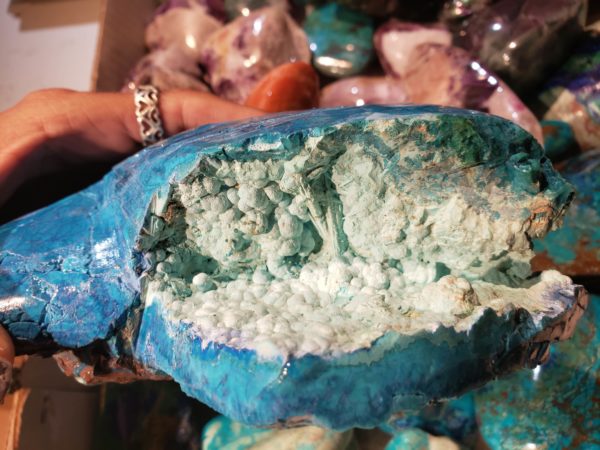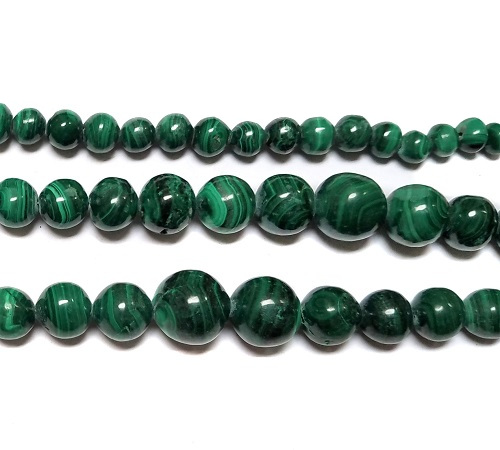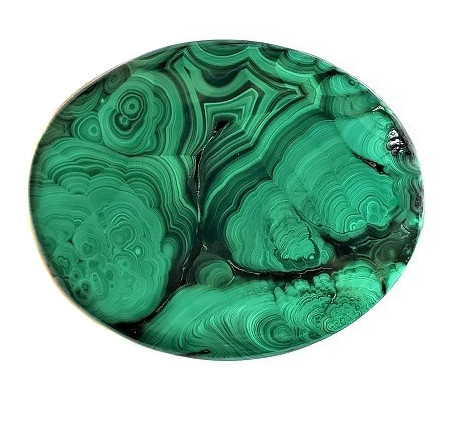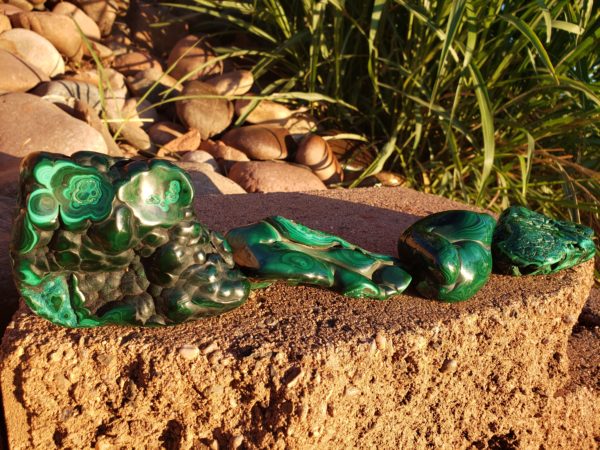Malachite (Cu2Co3Oh2) is an important copper ore mineral, ranging in color from bright to dark green. Its color tone can be as varied as its crystal formations. It can appear as a light pastel shade to a rich jewel tone to almost black and anywhere in between. Along with its rich green color, it frequently presents itself with concentric rings and banding. Malachite is considered to be a secondary mineral made up of Copper Carbonate. It is almost always formed by a chemical reaction between the weathering of copper ore deposits mixing with carbonates present in the surrounding limestone. Malachite is often found closer to the surface, in the oxidation zones of copper deposits together with the blue copper carbonate mineral called Azurite. Malachite and Azurite have an interesting relationship with each other in that Malachite can also form as a result of being a pseudomorph of Azurite.
Malachite has been mined for thousands of years and notable historic deposits include King Solomans mines in Timna Israel and the Ural Mountains in Russia. Well known contemporary deposits include large open pit mines in The Democratic Republic of Congo, as well as the famous American copper mines of Bisbee and Morenci located in Arizona. There are also significant deposits found in Namibia, Mexico, Australia, France, and other parts of The United States.
MALACHITE CRYSTAL STRUCTURE

Malachite presents itself in a variety of crystal aggregate structures. A botryoidal or bubble-like crystal shape is one of the most frequently occurring aggregate formations that Malachite displays. However, it is interesting to note that the botryoidal formation of Malachite is actually made up of long slender acicular or needle-like crystals, that when tightly grouped together, create botryoidal formations or ‘balls’ in appearance. Malachite can also present itself in a botryoidal formation as stalactites and stalagmites, which are the mineral columns that are formed in caves.
MALACHITE AS A PSEUDOMORPH

It is extremely rare for Malachite to form individual crystals. The exception is called a pseudomorph. The word ‘Pseudomorph’ literally means ‘false form’. A pseudomorph is a crystal consisting of one mineral but having the form of another which it has replaced. When Malachite is found in well defined singular crystals, it’s almost always a pseudomorph of Azurite. Azurite forms first and then is replaced later by malachite. These changes often occur on the exposed surfaces of copper with limestone deposits, resulting in pseudomorphs which contain a core of unaltered original material. Malachite pseudomorphs often appear as tabular crystal shapes, indicative of common Azurite crystal structures. There are even occurrences of triple pseudomorphs that include the mineral chrysocolla. For example, chrysocolla after Malachite after Azurite is an occurrence where the mineral begins as Azurite, then turns to Malachite and then ultimately into chrysocolla, but maintains the original crystal structure of Azurite. At other times, Azurite and Malachite grow together and even alongside each other, creating beautiful vibrantly colored specimens of jewel toned green Malachite juxtaposed with brilliant blue Azurite.
HISTORY OF MALACHITE
The name Malachite comes from the Greek word malache or mallow, because it looks like the leaves of the mallow plant.
The stone’s name could also derive from the different Greek word malakos, which translates to the english word ‘soft’. The hardness of Malachite is 3.4 on the Mohs scale, which makes Malachite a relatively ‘soft’ mineral.
Malachite has a very ancient past. There is significant archaeological evidence that Malachite was first discovered and mined, in the famous mines of King Solomon, located in Timna, Israel. Malachite was also a well known stone in ancient Egypt, and there is more evidence that it was mined in Egypt as early as 3000 BC. Ancient Egyptians used Malachite to decorate the elaborate headdresses and death masks of the pharaohs as well as amulets, talisman, and jewelry. Ancient Egyptians even turned Malachite into a powder and both males and females used it as an eyeshadow. Malachite was also popular with ancient Greeks, and Romans, who used it for jewelry, ornamentation, and for eye make up as well. During the middle ages, Malachite was believed to be a protection stone and was worn in jewelry in order to protect against the evil eye. The Russian Czars used Malachite from a large deposit in the Ural mountains, to produce ornaments and paneling for their castles as well as intricate inlay work.
MALACHITE USES

Malachite is not only used in jewelry, it is also used as both a decorative and as a sculptural stone. Malachite can be seen in intricate inlay in furniture, as well sculptures, beads, spheres, and cabochons for jewelry. Malachite is also well known as a pigment. By crushing it into a fine powder and mixing it with linseed oil Malachite was used in all green colored paints until 1800. There are even some contemporary artists who use Malachite for the green color in their paintings.
FAMOUS AND NOTABLE EXAMPLES OF MALACHITE:
URAL MOUNTAIN MALACHITE FROM RUSSIA
One of The most notable deposits of Malachite was discovered in the Ural Mountains of Russia during the early and mid 19th century. A tremendous amount of Malachite was mined in the Ural mountain region during this era. The biggest piece of Malachite discovered during this time weighed about 500,000 pounds! Unfortunately, this region was over mined, mostly to the point of extinction, and today there are only small deposits left. During this period, malachite was widely used for many things. This mineral was used as decorative building material such as tiles and columns, as well as inlay work for furniture and also used to paint the roofs of the houses located in the Ural mountains. This region was also famous for the making of beautiful Malachite jewelry boxes that continue to be recreated even now.
THE WINTER PALACE MALACHITE ROOM – AN EXTRAORDINARY EXAMPLE OF RUSSIAN MOSAIC
The Winter Palace Malachite Room is an extraordinary example of Russian mosaic. It is a landmark located in St. Petersburg Russia. Housed inside this palace is a room that was designed in the late 1830’s called the Malachite Room because it contains one of the most impressive displays of Malachite ever created. Malachite is featured in the fireplace, tables, wall tiles, columns, decorative vases, and urns. These items are all made entirely out of Malachite mined from the Ural mountains in Russia. These highly decorative columns appear as big solid masses but in reality are mosaic tiles of intricate inlay work. There is a reason for the mosaic nature of the inlay. The small size of malachite formations does not allow for the possibility to make large monolithic decorative items such as these columns. So instead, a highly impressive mosaic inlay was created to give the appearance of large monolithic items.
MALACHITE IN LAPIDARY
Malachite is a relatively soft material, with a Mohs hardness of 3.5-4. Despite the fact that it is soft, it is still considered a highly workable material. Malachite is not only used in jewelry but also as a sculptural stone.
When cutting malachite, we recommend to use water as a coolant on your wheels to remove airborne dust. Care should be taken to wash hands before eating and wear face protection to keep from breathing in any dust, because it contains arsenic. Reasonable precautions will keep one safe. It will polish well with tin oxide, Zam (green rouge) and diamond.
METAPHYSICAL PROPERTIES OF MALACHITE
- Chakras: Heart (4th), Throat (5th), Third Eye (6th)
- Element: Fire
- Numerology: Number 9
- Zodiac Signs: Capricorn, Scorpio
- Crystal Energy: Protection, a Healed Heart
Malachite is known for the properties of good luck and putting situational odds in your favor. Malachite is also known as a stone for creating wealth and aiding in prosperity. Malachite resonates with the heart chakra and because of this, it’s considered to be healing when it comes to matters of the heart. Malachite is also considered to be a protection stone and a great to take with you when traveling to help ensure a safe and enjoyable journey.

COPPER CANYON LAPIDARY LOVES MALACHITE
Here at Copper Canyon Lapidary, we absolutely love Malachite and it is considered to be one of our favorite minerals! The lapidary side of our business was founded on the specialization of cutting and polishing copper carbonates cabochons in particular and it’s why malachite will always have a soft spot in our heart. Marvelous Malachite is available on our website at Copper Canyon Lapidary. We have some beautiful Malachite cabochons, Malachite beads and Malachite slabs, for sale on our website as well as some interesting slabs of Azurite and Malachite pressed block slabs. Also keep an eye out for Malachite sculptural polished pieces from The Democratic Republic of Congo that will soon be listed on our website! Click on the above links to check out the beautiful malachite we have available for sale!

